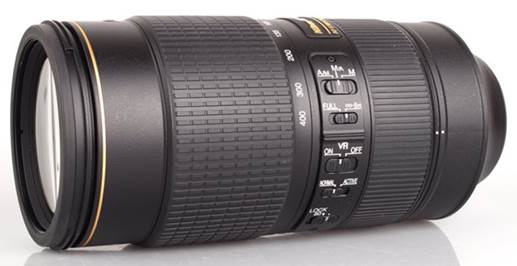Among all of the Nikon lenses, the 80-400 mm
lens has been updated for some time. The old lens had a reputation for being
slow and clunky. Fortunately, this new lens may not be like so thanks to the
autofocus mechanism, Nano-Crystal coating to help control light and reduce
vibration. However, it costs about $3,300. In this article, we will find out
its handling activities and improvements.
Features and Handling

The
product image
This lens is heavier than the old ones; its
tip weighs less than 1.6 kg. Although this is normal from a lightweight lens,
the size and design make this weight relatively easy to process. As a result,
it is on par with the Nikon D600 used for testing, even when there is no MB-D14
battery grip. The bar is made from a combination of high-quality plastics and
metal and is sealed.
Autofocus is equipped with a silent wave
motor, and the autofocus is fast and accurate. Manual adjustments can be
applied at any time via the focusing ring. The wide focusing ring, which lies
close to the camera body is smooth, and also reduces the size, which makes the
adjustment by hand easily. Autofocus is also possible using a 1.4x remote
converter with autofocus support at aperture as low as f/8.

The
product image
Closest focusing distance is 175cm when
using autofocus mechanism, and 150cm when using manual focus. When focusing
made with the 77 mm filter that does not rotate; but we had better use the lens
with graduated filters and polarizers. A tough metal tripod collar is included
with the lens, which is easily removed when it is not necessary.
The anti-vibration system promises to shoot
at shutter speeds up to four stops slower than without the technology. Like
other VR lenses, there is a short pause before capturing a photo for the best
results. With care, hand-held shooting at 1/25 sec is possible at 400 mm with a
reasonable amount. There are around four stops slower than normal. The VR
system in this lens really enables the viewfinder to stabilize well, which
helps with focusing at telephoto focal lengths.

The
product image
Performance
At 80mm maximum aperture, sharpness in the
center of the frame is really excellent, and the sharpness at the edges of the
frame is great. Stopping down the aperture to between f/8 and f/11 gives the result
of striking sharpness across the frame.
Performance is similar to the lens zoomed
to 200mm, with stunning sharpness in the center of the frame; and clarity is
not far behind towards the edges of the frame at maximum aperture. Like the
case at 80mm, peak clarity across the frame reaches between f / 8 and f/11,
where sharpness across the frame is excellent.
Finally, zooming to 400 mm does not reduce
the sharpness, but the lens still works well. At f/5.6, clarity is very good in
the center of the frame, and good towards the edges of the frame. Stopping down
to f/11 results in mainly focusing across the frame made with this focal
length, with excellent sharpness in the center and very decent clarity towards
the edges of the frame.

MTF@80mm

MTF@200mm

MTF@400mm
How
to read the charts
The blue column stands for sharpness in the
center of the frame at various apertures and the green is from the edges. The
red column presents the average.
The ratio on the left side shows the actual
image resolution. The taller the column is, the better the lens performance is.
It is simple.
In this article, the lens was tested on a
Nikon D600 using Imatest.
For a super-telephoto lens, chromatic
aberrations are well controlled. Fringing is the most popular towards the edges
of the frame at 80mm with the aperture established at f/16 or more. Even then
half a pixel width of fringing is hardly exceeded.

CA@80mm

CA@200mm

CA@400mm
How
to read the charts
Chromatic aberration is meant that the lens
is unable to focus on the sensor or film all colors of visible light at the
same point. Severe chromatic aberration produces a remarkable fringing or a
halo effect around sharp edges within the image. It may be cured in software.
Apochromatic lenses features special lens
elements aspheric, low dispersion, etc. to minimize the problem, therefore,
they usually cost more.
In this article, the lens was tested on a
Nikon D600 using Imatest.
Illumination towards the corners is
reasonable for a telephoto zoom lens. At maximum aperture of 80 mm, the corners
are only 1.3 stops darker than the image center; and visually uniform
illumination is achieved with the lens stopped at f / 8 or beyond. At 400 mm,
the corners are 1.66 stops darker corners; and visually uniform illumination is
done with the aperture stopped at f/11 or more.
Imatest detected rather consistent
pincushion distortion throughout the zoom range from 0.6% at 80 mm and 0.768%
at 400mm. This is the low level of distortion that should not raise too many
issues. If the lines are completely straight, you will be glad when the
distortion model is uniform throughout the zoom range, which should apply
corrections in relatively simple image editing software.
Thanks Nano Crystal coating of Nikon, the
ratios of glare and ghosting rarely happen, conversely mounts very well, even
when shooting in light at the maximum aperture. A deep hole with a bit of
cut-out flower comes with the lens, which does not have enough functionality to
shade the lens from extraneous light that is likely to cause problems.

Sample
images
Value
Just like with any lens that has just been
launched, the asking price seems to be a first point of attention, especially
when the lens is currently priced at $ 3,300 compared with other available
lenses that cost under half that. Even with the difference in price, this lens
is still a worthwhile purchase, as an upgrade, or simply because you need a
lens like this. The difference in performance between the two is such that the
new lens is much easier to use, and generally gives better results.
Those who have a limited budget might also
take a look at Sigma's 120-400mm DG OS HSM lens, which is available for around
$ 945. This lens has many similar features, including optical image stabilization
and static autofocus, but it does not offer the same performance level as the
Nikon lens.

Nikon
Nikkor ED VR II
Conclusion
Nikon has updated the 80-400mm lens for a
year, and now it's here to prove that it is worth the wait.
It provides sharp images, focuses fast and
is easy to use. In reality, its asking price of $ 3,300 is almost negligible. I
said almost, because, partly it is still a reasonable amount of cash.
Info
·
Product name: Nikon AF-S NIKKOR 80-400mm
f/4.5-5.6G ED VR
·
Price: $ 3,300
Pros
·
Sharpness is great.
·
Static focusing is fast.
·
CA is very low.
·
Distortion is low.
·
It does not make the changes of colors in spite
of the weather
·
VR System is effective.
Cons
·
It may be considered to be expensive at current
prices
Technical
specifications
|
General
·
Lens Mounts: Nikon AF
Lens
·
Focal Length: 80mm - 400mm
·
Angle of View: No Data
·
Max Aperture: f/4.5 - f/5.6
·
Min Aperture: f/32 - f/40
·
Filter Size: 77mm
·
35mm equivalent: No Data
·
Internal focusing: Yes
Focusing
·
Min Focus: 150cm
·
Stabilized: Yes
Construction
·
Blades: 9
·
Elements: 20
·
Groups: 12
Box Contents
·
Box Contents: Lens Case CL-M2, Lens Cap LF-4,
Lens Cap LC-77
Dimensions
·
Weight: 1,570g
·
Height: 203mm
|